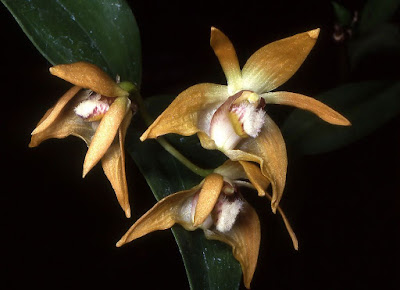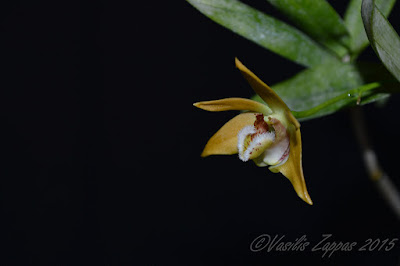Dendrobium fleckeri is native to Northeast of Australia. They are found in the southeastern part of the Cape York peninsula between the Johnston and Annan rivers in rain forests on mountain peaks at an altitude of 800-1500 m, where abundant dew, fog and low clouds are common.
Dendrobium fleckeri, also called as Flecker's Dendrobium (named to honor the Australian Orchid Collector), Apricot Cane Orchid, Thelychiton fleckeri, Tropilis fleckeri, is a species of the genus Dendrobium. This species was described by Rupp & C.T. White in 1937.
IDENTIFY DENDROBIUM FLECKERI
Dendrobium fleckeri is native to Northeast of Australia. They are found in the southeastern part of the Cape York peninsula between the Johnston and Annan rivers in rain forests on mountain peaks at an altitude of 800-1500 m, where abundant dew, fog and low clouds are common. These orchids grow, as a rule, on trees, but at higher altitudes they can also occur on rocks, in this case the plants are small, with spindle-shaped pseudobulbs.
It is a small sized, cool to cold growing epiphyte or a miniature sized lithophyte, which reaching 10-30 cm in height, with erect to nearly pendulous rugose with age, apically leafy, 10-30 cm long canes with thin, ovate, 3-8 cm long leaves.
Flecker's Dendrobium blooms in the late winter through early summer on a 0.4 to 0.8" (1 to 2 cm) long, 1 to 3 flowered inflorescence which emerge from the apical nodes of the stem and carries 1 to 3, spicely fragrant flowers. The flowers are 2.5 cm in diameter. The wide flakes of the outer whorl, the slightly narrower flakes of the inner whorl and the large, densely covered hairs of the lip usually have a peach-yellow to yellowish-green color. Sometimes, but rarely, clones with nearly brown flowers are found. At higher heights, the plants are smaller, but the size of the flowers remains the same and their color is more intense.
DENDROBIUM FLECKERI CARE AND CULTURE
Cultural information should only be used as a guide, and should be to be adapted to suit you. Your physical location; where you grow your plants, how much time you have to devote to their care, and many other factors, will need to be taken into account. Only then can you decide on the cultural methods that best suit you and your plants.
Light:
Dendrobium fleckeri needs a light level of 18000-25000 lux. Strong air movement is required all the time.
Temperature:
The average temperature of the summer day is 24-25 ° C, night 16 ° C, which gives a daily difference of 8-9 ° C. The average temperature of the winter day is 18-21 ° C, and the winter night is 9-11 ° C, giving a daily difference of 8-11 ° C.
Humidity:
Flecker's Dendrobium needs a humidity of 75-80% throughout the year. The plants are healthier if they are provided with high humidity and strong air movement throughout the year.
Substrate, growing media and repotting:
Dendrobium fleckeri can be grown on rootstocks if they can be watered at least once a day throughout the year. Additional fogging is required during very warm summer days. To keep the roots constantly moist, use as small pots as possible, but with a very loose substrate. This substrate should almost dry out between waterings, but it can never be completely dry. Repotting is best done immediately after flowering, when new roots begin to grow.
Watering:
Water is abundant from spring to autumn, but in the winter it is a bit drier. The plants should be constantly moist during the growing season, with only little drying between watering.
Fertilizer:
It is recommended to apply a 1/4-1/2 dose of orchid fertilizer weekly. High-nitrogen fertilizer is beneficial from spring to mid-summer, and then use high-phosphoric fertilizer.
Rest period:
From late autumn until the beginning of spring, or for a period of 4-5 months, the amount of water should be reduced. Dendrobium fleckeri should dry out between waterings, but they can never remain completely dry, even in winter. Light, humidity and air movement should remain the same, but fertilization should be reduced and one light fertilization applied every 2-3 weeks until spring, when watering increases.















COMMENTS